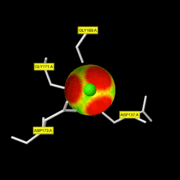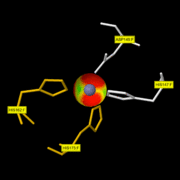Sandbox Reserved 1125
From Proteopedia
(Difference between revisions)
| Line 15: | Line 15: | ||
The difference between this classification and EC 3.4.24.7 is that this enzyme cleaves type III collagen more slowly than type I. | The difference between this classification and EC 3.4.24.7 is that this enzyme cleaves type III collagen more slowly than type I. | ||
| - | (On [http://www.brenda-enzymes.org/enzyme.php?ecno=3.4.24.34&UniProtAcc=P22894&OrganismID=2681 BRENDA], you can find all pieces of information about the | + | (On [http://www.brenda-enzymes.org/enzyme.php?ecno=3.4.24.34&UniProtAcc=P22894&OrganismID=2681 BRENDA], you can find all pieces of information about the MMP-8 enzyme like, for example, a list of different substrates or inhibitors) |
== Structure and domains == | == Structure and domains == | ||
| - | MMP-8 is composed of several domains: a propeptide, a catalytic domain, a hinge region, and a C-terminal | + | MMP-8 is composed of several domains: a propeptide, a catalytic domain, a hinge region, and a C-terminal hemopexin-like domain.<ref name="Pdf">[https://www.google.fr/url?sa=t&rct=j&q=&esrc=s&source=web&cd=5&cad=rja&uact=8&ved=0ahUKEwipxN6imszKAhVCPxoKHR5QDC4QFghFMAQ&url=http%3A%2F%2Fwww.springer.com%2Fcda%2Fcontent%2Fdocument%2Fcda_downloaddocument%2F9780896036680-c2.pdf%3FSGWID%3D0-0-45-494797-p173728219&usg=AFQjCNHRfP-tVHWXP2ljUTd3MjjhObqnCA&sig2=6RnjnFvqo7PVhxvSDDsOlw Substrate specificity of MMPs]</ref>. |
=== Propeptide === | === Propeptide === | ||
| Line 26: | Line 26: | ||
=== Catalytic domain === | === Catalytic domain === | ||
| - | Thanks to X-ray crystallography, the catalytic domain structure has been solved with 1,7 Å resolution (2OY4).This domain is composed of 157 residues, from Met86 to Gly242, organized in <scene name='71/719866/Helixes/4'>three alpha helixes</scene> and <scene name='71/719866/Sheets/3'>five beta sheets</scene>.The protein folding and especially the zinc environment of the collagenase catalytic domain is very close to the astacins and the snake venom metalloproteinases. The catalytic domain alone has proteolytic activity against other protein substrates and synthetic substrates.<ref name="X-ray">PMID:8137810</ref> | + | Thanks to X-ray crystallography, the catalytic domain structure has been solved with 1,7 Å resolution (PDB ID : 2OY4).This domain is composed of 157 residues, from Met86 to Gly242, organized in <scene name='71/719866/Helixes/4'>three alpha helixes</scene> and <scene name='71/719866/Sheets/3'>five beta sheets</scene>.The protein folding and especially the zinc environment of the collagenase catalytic domain is very close to the astacins and the snake venom metalloproteinases. The catalytic domain alone has proteolytic activity against other protein substrates and synthetic substrates.<ref name="X-ray">PMID:8137810</ref> |
==== Subsites ==== | ==== Subsites ==== | ||
| - | Besides the catalytic site, the MMPs have other sites called subsites which can also interact with the substrates and inhibitors. Conventionally, the subsites on the left of the catalytic Zn2+ are designated as S1, S2, S3,..., Sn and the ones on the right are known as S1', S2', etc. | + | Besides the catalytic site, the MMPs have other sites called subsites which can also interact with the substrates and inhibitors. Conventionally, the subsites on the left of the catalytic Zn2+ are designated as S1, S2, S3, ..., Sn and the ones on the right are known as S1', S2', etc. |
One of these subsites, the S1' pocket, is the main subsite for the substrate recognition. This pocket is variable in amino acid composition and depth and can be used to classify the MMPs. | One of these subsites, the S1' pocket, is the main subsite for the substrate recognition. This pocket is variable in amino acid composition and depth and can be used to classify the MMPs. | ||
| Line 57: | Line 57: | ||
=== Hinge domain === | === Hinge domain === | ||
| - | It corresponds to a short linker region from G242 to P258, with the following sequence: GLSSNPIQPTGPSTPKP, between the catalytic and the hemopexin domains. The exact role of this domain isn't very well clear but it's known that autoproteolysis could occurred in | + | It corresponds to a short linker region from G242 to P258, with the following sequence: GLSSNPIQPTGPSTPKP, between the catalytic and the hemopexin domains. The exact role of this domain isn't very well clear but it's known that autoproteolysis could occurred in MMP-8 leading to an unstable protein and different mutants<ref name="hinge">PMID:9094424</ref> were made in the hinge region and shown that stability of MMP-8 could be increased, decreased or unchanged. Moreover, sequence alignements of collagenolytic MMPs in this hinge domain reveal that they all have the four prolines in the same positions, suggesting that these prolines could be important for the specific collagenolytic activity. |
=== Hemopexin domain === | === Hemopexin domain === | ||
| Line 64: | Line 64: | ||
It seems that the collagen binds to two sites on MMP-8 : one in the catalytic site and another in the hemopexin domain. One hypothesis is that when the collagen binds to both sites, its helical structure is destabilized and unwound. Thus, the cleavage site of collagen is accessible and the cleavage reaction can occur.[http://www.jleukbio.org/content/81/4/870.full] | It seems that the collagen binds to two sites on MMP-8 : one in the catalytic site and another in the hemopexin domain. One hypothesis is that when the collagen binds to both sites, its helical structure is destabilized and unwound. Thus, the cleavage site of collagen is accessible and the cleavage reaction can occur.[http://www.jleukbio.org/content/81/4/870.full] | ||
| - | Unfortunately, no structure of the full | + | Unfortunately, no structure of the full MMP-8 protein has been crystallized yet, but <scene name='71/719866/Human_prommp-1_structure/1'>here</scene> you can see in orange the hemopexin domain of human pro-MMP1 which is very well conserved between these two proteins, by the way you can find in this article: [http://www.fasebj.org/content/12/12/1075.full#ref-27 Matrix metalloproteinases: structures, evolution, and diversification,Irina Massova, Lakshmi P. Kotra, Rafael Fridman and Shahriar Mobashery], good pieces of information on conservations among the MMPs family. |
| Line 73: | Line 73: | ||
The cleavage is at Gly775–Ile776 or Leu776 in each alpha-chain of the collagen molecule<ref name="hinge"/> and takes place at neutral pH. It generates fragments that spontaneously lose their helical conformation, denature to gelatin, and become soluble. The gelatin is then susceptible to attack by gelatinases and other proteases.<ref>[http://www.ebi.ac.uk/interpro/entry/IPR028709 "Neutrophil collagenase"]</ref> | The cleavage is at Gly775–Ile776 or Leu776 in each alpha-chain of the collagen molecule<ref name="hinge"/> and takes place at neutral pH. It generates fragments that spontaneously lose their helical conformation, denature to gelatin, and become soluble. The gelatin is then susceptible to attack by gelatinases and other proteases.<ref>[http://www.ebi.ac.uk/interpro/entry/IPR028709 "Neutrophil collagenase"]</ref> | ||
| - | There is no crystallized complex of | + | There is no crystallized complex of MMP-8 and the collagen, however you can see <scene name='71/719866/Mmp1_complexed_with_collagen/2'>here</scene> the complex of MMP-1 and a triple-helical collagen peptide, MMP-1 being very close to MMP-8 it gives an idea of the MMP8-collagen complex. |
Revision as of 18:15, 30 January 2016
Matrix metalloproteinase-8
MMP-8, also called, Neutrophil collagenase or Collagenase 2, is a zinc-dependent and calcium-dependent enzyme. It belongs to the matrix metalloproteinase (MMP) family which is involved in the breakdown of extracellular matrix in embryonic development, reproduction, and tissue remodeling, as well as in disease processes. The gene coding this family is localized on the chromosome 11 of Homo sapiens with 467 residues.[1]
is the reloading for the initial structure of the catalytic domain of MMP-8.
| |||||||||||
References
- ↑ "MMP-8 matrix metallopeptidase 8 (neutrophil collagenase)"
- ↑ "Metalloendopeptidase activity"
- ↑ 3.0 3.1 Substrate specificity of MMPs
- ↑ 4.0 4.1 4.2 Bode W, Reinemer P, Huber R, Kleine T, Schnierer S, Tschesche H. The X-ray crystal structure of the catalytic domain of human neutrophil collagenase inhibited by a substrate analogue reveals the essentials for catalysis and specificity. EMBO J. 1994 Mar 15;13(6):1263-9. PMID:8137810
- ↑ Gupta SP, Patil VM. Specificity of binding with matrix metalloproteinases. EXS. 2012;103:35-56. doi: 10.1007/978-3-0348-0364-9_2. PMID:22642189 doi:http://dx.doi.org/10.1007/978-3-0348-0364-9_2
- ↑ Verma RP, Hansch C. Matrix metalloproteinases (MMPs): chemical-biological functions and (Q)SARs. Bioorg Med Chem. 2007 Mar 15;15(6):2223-68. Epub 2007 Jan 17. PMID:17275314 doi:http://dx.doi.org/10.1016/j.bmc.2007.01.011
- ↑ 7.0 7.1 Knauper V, Docherty AJ, Smith B, Tschesche H, Murphy G. Analysis of the contribution of the hinge region of human neutrophil collagenase (HNC, MMP-8) to stability and collagenolytic activity by alanine scanning mutagenesis. FEBS Lett. 1997 Mar 17;405(1):60-4. PMID:9094424
- ↑ Hirose T, Patterson C, Pourmotabbed T, Mainardi CL, Hasty KA. Structure-function relationship of human neutrophil collagenase: identification of regions responsible for substrate specificity and general proteinase activity. Proc Natl Acad Sci U S A. 1993 Apr 1;90(7):2569-73. PMID:8464863
- ↑ Van Wart HE, Birkedal-Hansen H. The cysteine switch: a principle of regulation of metalloproteinase activity with potential applicability to the entire matrix metalloproteinase gene family. Proc Natl Acad Sci U S A. 1990 Jul;87(14):5578-82. PMID:2164689
- ↑ Chung L, Dinakarpandian D, Yoshida N, Lauer-Fields JL, Fields GB, Visse R, Nagase H. Collagenase unwinds triple-helical collagen prior to peptide bond hydrolysis. EMBO J. 2004 Aug 4;23(15):3020-30. Epub 2004 Jul 15. PMID:15257288 doi:http://dx.doi.org/10.1038/sj.emboj.7600318
- ↑ Piccard H, Van den Steen PE, Opdenakker G. Hemopexin domains as multifunctional liganding modules in matrix metalloproteinases and other proteins. J Leukoc Biol. 2007 Apr;81(4):870-92. Epub 2006 Dec 21. PMID:17185359 doi:http://dx.doi.org/10.1189/jlb.1006629
- ↑ 12.0 12.1 Visse R, Nagase H. Matrix metalloproteinases and tissue inhibitors of metalloproteinases: structure, function, and biochemistry. Circ Res. 2003 May 2;92(8):827-39. PMID:12730128 doi:http://dx.doi.org/10.1161/01.RES.0000070112.80711.3D
- ↑ "Neutrophil collagenase"
- ↑ Nagase H, Visse R, Murphy G. Structure and function of matrix metalloproteinases and TIMPs. Cardiovasc Res. 2006 Feb 15;69(3):562-73. Epub 2006 Jan 5. PMID:16405877 doi:http://dx.doi.org/10.1016/j.cardiores.2005.12.002
- ↑ [http://www.rcsb.org/pdb/explore/explore.do?structureId=1UEA "Metalloprotease-Inhibitor Complex
- ↑ Brew K, Nagase H. The tissue inhibitors of metalloproteinases (TIMPs): an ancient family with structural and functional diversity. Biochim Biophys Acta. 2010 Jan;1803(1):55-71. doi: 10.1016/j.bbamcr.2010.01.003. , Epub 2010 Jan 15. PMID:20080133 doi:http://dx.doi.org/10.1016/j.bbamcr.2010.01.003
- ↑ Jacobsen JA, Major Jourden JL, Miller MT, Cohen SM. To bind zinc or not to bind zinc: an examination of innovative approaches to improved metalloproteinase inhibition. Biochim Biophys Acta. 2010 Jan;1803(1):72-94. doi: 10.1016/j.bbamcr.2009.08.006. , Epub 2009 Aug 25. PMID:19712708 doi:http://dx.doi.org/10.1016/j.bbamcr.2009.08.006
- ↑ 'Crystal structure of the complex between MMP-8 and a N-hydroxyurea inhibitor'
- ↑ 'Crystal structure of the complex between MMP-8 and a non-zinc chelating inhibitor'
- ↑ "Extra Binding Region Induced by Non-Zinc Chelating Inhibitors into the S1′ Subsite of Matrix Metalloproteinase 8"
- ↑ Savill NJ, Weller R, Sherratt JA. Mathematical modelling of nitric oxide regulation of rete peg formation in psoriasis. J Theor Biol. 2002 Jan 7;214(1):1-16. PMID:11786028 doi:http://dx.doi.org/10.1006/jtbi.2001.2400
- ↑ Larochelle C, Alvarez JI, Prat A. How do immune cells overcome the blood-brain barrier in multiple sclerosis? FEBS Lett. 2011 Dec 1;585(23):3770-80. doi: 10.1016/j.febslet.2011.04.066. Epub, 2011 May 4. PMID:21550344 doi:http://dx.doi.org/10.1016/j.febslet.2011.04.066
- ↑ Westermarck J, Kahari VM. Regulation of matrix metalloproteinase expression in tumor invasion. FASEB J. 1999 May;13(8):781-92. PMID:10224222
- ↑ Liu KZ, Hynes A, Man A, Alsagheer A, Singer DL, Scott DA. Increased local matrix metalloproteinase-8 expression in the periodontal connective tissues of smokers with periodontal disease. Biochim Biophys Acta. 2006 Aug;1762(8):775-80. Epub 2006 Jul 22. PMID:16928431 doi:http://dx.doi.org/10.1016/j.bbadis.2006.05.014
- ↑ Balbin M, Fueyo A, Knauper V, Pendas AM, Lopez JM, Jimenez MG, Murphy G, Lopez-Otin C. Collagenase 2 (MMP-8) expression in murine tissue-remodeling processes. Analysis of its potential role in postpartum involution of the uterus. J Biol Chem. 1998 Sep 11;273(37):23959-68. PMID:9727011
- ↑ Brand KH, Ahout IM, de Groot R, Warris A, Ferwerda G, Hermans PW. Use of MMP-8 and MMP-9 to assess disease severity in children with viral lower respiratory tract infections. J Med Virol. 2012 Sep;84(9):1471-80. doi: 10.1002/jmv.23301. PMID:22825827 doi:http://dx.doi.org/10.1002/jmv.23301
- ↑ Gao M, Nguyen TT, Suckow MA, Wolter WR, Gooyit M, Mobashery S, Chang M. Acceleration of diabetic wound healing using a novel protease-anti-protease combination therapy. Proc Natl Acad Sci U S A. 2015 Dec 8;112(49):15226-31. doi:, 10.1073/pnas.1517847112. Epub 2015 Nov 23. PMID:26598687 doi:http://dx.doi.org/10.1073/pnas.1517847112


